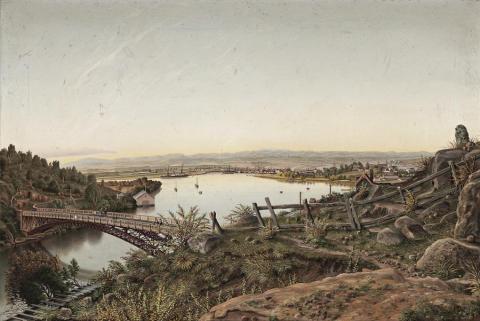VIEW OF LAUNCESTON, 1881
JOHN CAMPBELL
oil on canvas
71.5 x 106.5 cm
inscribed verso: VIEW OF LAUNCESTON / by John CAMPBELL / 1881. / VALUE £20
inscribed verso: WINDSOR & NEWTON, LONDON
Won in a raffle organized by the artist, Launceston, c.1881
Mrs. Herring, Ringarooma, Tasmania
Thence by descent
Mr. L. W. Cordell, Launceston
Thence by descent
Private collection, Launceston
Private collection, Adelaide
The recent discovery of this rare and important panoramic View of Launceston, 1881, sheds new light on John Campbell's first years in Australia as well as adding an iconic painting to late colonial Australian art history.
Born in Scotland in 1855, there has been uncertainty as to when the artist arrived in Australia and where he spent his first years before eventually settling in Perth at the turn of the century. Until now the earliest known works by Campbell were painted in Brisbane between 1887 and 1889; a view of the Brisbane River from North of Victoria (Bridge), 1887 and Railway Hotel, Brisbane, 1889.
It is known that Campbell married Lucy Evans in Tasmania in 1883 and raised a family with some hardship. With the discovery of this early painting we can now assume that Campbell spent at least several years in the early 1880s residing in Tasmania, most likely in Launceston, before travelling to Brisbane by 1887. He is recorded as working in New South Wales and Sydney in 1895 and by the early 1900s had settled in Perth.
Painted in 1881, the decade of the Centenary, Campbell's View of Launceston observes the ending of the Colonial era - the rugged rocky landscape and dilapidated wooden fence in the foreground, giving way to a fast growing and vibrant city with open pastures beyond. Soon after painting this work, Campbell raffled the painting in Launceston to raise funds for future endeavours. The artist had given a raffle ticket to Mrs Herring, owner of the hotel at Ringarooma in appreciation of 'kindness he never forgot'. 'It won her the View of Launceston, a prize she treasured for life'1., which remained in the possession of the family for the next 100 years.
A retrospective exhibition of John Campbell (1855-1924) was held at the Art Gallery of Western Australia in 2003.
Dr. Eric Ratcliff, Architectural Historian, Launceston, has kindly provided the following information regarding the subject:
Launceston was founded in 1806 at the head of the estuary of the River Tamar, 65 kilometres from the sea, where the North and South Esk Rivers enter the tidewater. It is the third oldest established city in Australia, and by 1881, it was in size and importance the eighth city in the Australian Colonies, the entrepot and commercial centre of Northern Tasmania, with a rich agricultural and pastoral hinterland, exporting timber and servicing mines in the region.
The image is topographically accurate, but with some artistic condensation of the foreground and adjustment of the skyline. The viewpoint, looking north-east, is near the foot of what is now the Zig-Zag Reserve, named for the scenic path that climbs through the dolerite crags of the Cataract Gorge that appear in the foreground. The iron bridge, designed by the Irish railway engineer W. T. Doyne, prefabricated in Manchester and erected in 1862, spans the mouth of the Gorge of the South Esk, and shipping is shown in the old seaport in the mouth of the North Esk. The steamships with black and white funnels belonged to the Tasmanian Steam Navigation Company, plying between Melbourne and Launceston; the largest, off Town Point, is recognisable as the SS Flinders. Beyond the bridge appears the Tamar Rowing Club boatshed of 1877. On the right, the gabled toll-keeper's cottage appears above the slope, and below it can be seen the keeper's shelter beside the road, near the lady with the parasol. Below that, in the left foreground are segments of the wooden fluming that carried water from the Cataractto Ritchie's Mill, out of sight behind the hill. On the flats near the North Esk, the most prominent building is the red brick Commissariat Store of 1829; in 1881 it was the Victoria Barracks. On the hill behind the gabled cottage stands (left to right) Struan House, a merchant's mansion of 1870, the old Army Barracks of 1821-26 that had become the Invalid Depot, and the old Court House (1837 and 1841). Beyond them can be seen the spires of St Andrew's Kirk (1850), the taller Paterson Street Methodist Church (1866) and to the right of them is the town centre with Victoria Terrace on Windmill Hill beyond it. The background is the Eastern Tiers, with Mount Arthur prominent on the skyline, but the larger Mount Barrow much diminished, probably to enhance the composition.
1.'Old painting was prize in a raffle', The Examiner, Launceston, 15 April 1969, p. 25
